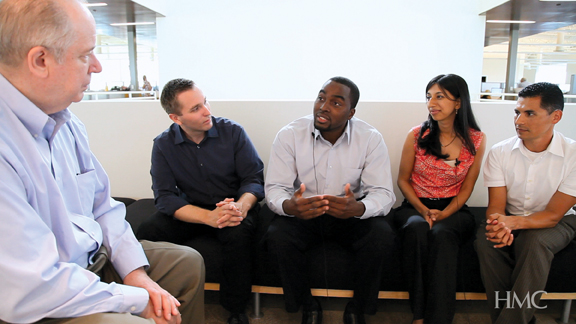“We take a multifaceted approach to professional development,” says Pasqual V. Gutierrez, AIA, Director of Architecture. Among HMC’s career development programs:
• IDP Forum, held once a month for those employees who are fulfilling the Intern Development Program. “We use the AIA Emerging Professional Companion in combination with specs of real HMC projects, so that they learn about specifications but also our HMC protocols,” says Gutierrez.
• After-hours study programs for employees preparing for the Architectural Registration Exam are supported by senior architects.
• Accessibility Workshop: a five-hour program held in odd-numbered years for employees—and clients—who need to meet state licensure renewal requirements for Mandatory Accessibility coursework.
• Access to 1,040 hours of the AIA Virtual Convention for 80 licensed architects at the firm to view and earn AIA/CES learning units.
The Emerging Leaders Forum is a two-year “corporate overlay experience” program for mid- and upper-level management-track staff to hone their corporate governance skills. Emerging leaders engage in reading assignments, community service, and professional practice mentoring sessions to help them refine their practical skills while providing insight into executive management.
At the top level, Principals, Associate Principals, and Senior Project Managers are provided a reimbursable allowance for conferences and books, plus each studio managing principal receives a discretionary fund to administer education and training for technical and administrative staff.
In what may be a unique offering, HMC recorded a thousand hours of its own lunch-and-learn “Back2Basics” learning workshops—covering such topics as BIM and cost controls—and contracted with the AIA to make them available online to HMC staff for continuing education credits.
Two employee-initiated forums meet after hours to explore issues in design, take field trips, make presentations, and enter competitions, all on their own time.
Every September, HMC’s ArchLab takes a group of 20 or so employees into the woods for a weekend retreat to dig into sustainability. “We don’t talk about LEED,” says Gutierrez. “We talk about high-performance architecture and the strategies you need to deliver it.”
More at: www.BDCnetwork.com/HMC/Careers. +
Related Stories
Transit Facilities | Feb 4, 2015
London mayor approves plan for a bicycle highway
The plan will guarantee bike riders a designated stretch of street to ride from east to west through the city.
Sports and Recreational Facilities | Feb 4, 2015
Arup unveils plans for the new A.C. Milan stadium
The venue will include a modern stage for the home matches together with a hotel, sports college, restaurants, children’s playground, green areas, and spaces open to the city and dedicated to public use.
Higher Education | Feb 3, 2015
Integrated Learning Neighborhoods: A solution for linking student housing with the typical student experience
Just as urban housing fits into the city as a whole, student housing can be integrated into the campus network as a series of living/learning neighborhoods, write Gensler's Brian Watson and Mark McMinn.
Office Buildings | Feb 3, 2015
5 trends transforming workplace design
RTKL's workplace design expert Jodi Williams foresees healthier and more technologically enabled offices that allow productive worker interaction, wherever they happen to be.
Architects | Feb 3, 2015
Frank Lloyd Wright’s work nominated for UNESCO World Heritage Status
If selected, Wright’s work will be the first examples of U.S. modern architecture on the list.
Contractors | Feb 3, 2015
Nonresidential construction spending expands in December 2014
Seven of 16 nonresidential construction subsectors posted increases in spending in December on a monthly basis.
Office Buildings | Feb 3, 2015
Bjarke Ingels' BIG proposes canopied, vertical village for Middle East media company
The tensile canopy shades a relaxation plaza from the desert sun.
Fire-Rated Products | Feb 3, 2015
AIA course: Fire and life safety in large buildings
Earn 1.0 AIA/CES learning units by studying this article and successfully completing the online exam.
Multifamily Housing | Feb 2, 2015
D.C. developer sees apartment project as catalyst for modeling neighborhood after N.Y.'s popular High Line district
It’s no accident that the word “Highline” is in this project’s name. The goal is for the building to be a kind of gateway into the larger redevelopment of the surrounding neighborhood to resemble New York’s City’s trendy downtown Meatpacking District, through which runs a portion the High Line elevated park.
Healthcare Facilities | Feb 1, 2015
7 new factors shaping hospital emergency departments
A new generation of highly efficient emergency care facilities is upping the ante on patient care and convenience while helping to reposition hospital systems within their local markets.

















